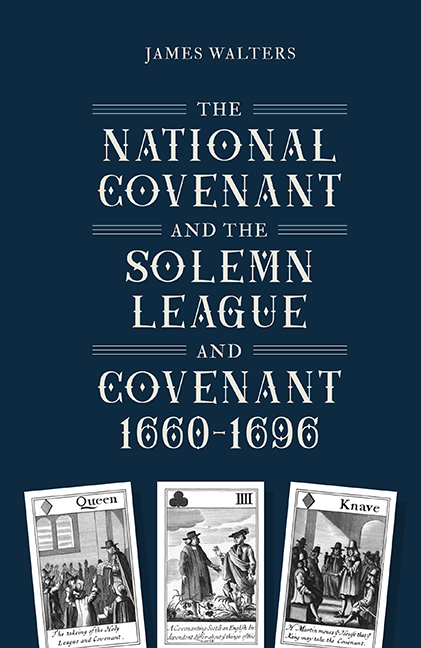Book contents
- Frontmatter
- Contentst
- List of Illustrations
- Acknowledgements
- Introduction
- 1 The 1638 National Covenant and the 1643 Solemn League and Covenant
- 2 1660: What Was to Be Restored?
- 3 The Act of Uniformity and the ‘Great Ejection’
- 4 Crisis and Toleration in the 1660s
- 5 Exclusion and Association in the Late Restoration Period
- 6 The Revolution of 1688 and the Association of 1696
- Conclusion
- Bibliography
- Index
- STUDIES IN EARLY MODERN CULTURAL, POLITICAL AND SOCIAL HISTORY
6 - The Revolution of 1688 and the Association of 1696
Published online by Cambridge University Press: 26 May 2022
- Frontmatter
- Contentst
- List of Illustrations
- Acknowledgements
- Introduction
- 1 The 1638 National Covenant and the 1643 Solemn League and Covenant
- 2 1660: What Was to Be Restored?
- 3 The Act of Uniformity and the ‘Great Ejection’
- 4 Crisis and Toleration in the 1660s
- 5 Exclusion and Association in the Late Restoration Period
- 6 The Revolution of 1688 and the Association of 1696
- Conclusion
- Bibliography
- Index
- STUDIES IN EARLY MODERN CULTURAL, POLITICAL AND SOCIAL HISTORY
Summary
By the late 1680s, the Covenants themselves featured only in a limited way in political discourse, primarily in a Scottish context. However, the political theories embodied in the Covenants featured heavily in the theory underlying the Revolution of 1688 and influenced the terms in which the Revolution was discussed. Resistance theory and ideas of contractual kingship which had previously been associated with Covenanting and sedition became commonplace. Sometimes, these ideas were justified with reference to the intellectual heritage of the Scottish reformation, other times with reference to England's history or to other factors such as Hebraic kingship. While not always directly influenced by the Covenants, the Whigs of the 1680s were attempting a project with many similarities to the Covenanters of the 1630s and 1640s. In both cases, what they were undertaking was a political revolution justified as safeguarding a certain conception of a threatened constitution of church and state. The intellectual tools which the Covenanters and 1688 Revolutionaries used to do this were similar as well – they argued they were simply defending a lawful status quo, and used oaths and associations as a means of organising this defence. As Clarendon phrased it in reference to the original Covenanters, ‘they united themselves by subscribing a covenant.’ So too did opponents of James II's succession and rule attempt to unite themselves with similar documents at various points from 1681 onwards, during the events surrounding the Revolution of 1688, and to defend William's crown and the revolutionary settlement afterwards.
Particularly in the Association of 1696, influence from the Covenants can be seen in the use of a widely signed oath which emphasised popular consent alongside constitutional lawfulness. The difference, however, was that this form had been appropriated for a much more expansive, pluralistic religious vision – a form of political Protestantism which was more inclusive than the presbyterianism of the Covenants, extending even to Catholics of sufficient political loyalty. The late 1680s and 1690s saw the narrowly jure divino presbyterian ecclesiology of the Covenants excluded from the new Revolutionary order. However, this period also saw unparalleled success for the combination of limited contractual monarchy, underpinned by mass popular politics, of which the Covenants still represented the most immediate historical example.
- Type
- Chapter
- Information
- Publisher: Boydell & BrewerPrint publication year: 2022



